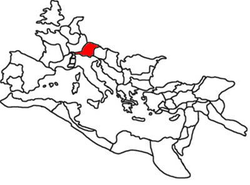Raetia
| Raetia Provincia Raetia | |||||||||||||
|---|---|---|---|---|---|---|---|---|---|---|---|---|---|
Augusta Vindelicorum | |||||||||||||
| Historical era | Antiquity | ||||||||||||
• Established | 15 BC | ||||||||||||
• Ostrogothic conquest[citation needed ] | 476 AD | ||||||||||||
| |||||||||||||
| Today part of | |||||||||||||

Raetia or Rhaetia (
It thus comprised the districts occupied in modern times by eastern and central
The capital of the province was
History
Little is known of the origin or history of the
The Raetians are first mentioned (but only incidentally) by Polybius,[1][5] and little is heard of them till after the end of the Republic. There is little doubt, however, that they retained their independence until their subjugation in 15 BC by Tiberius and Drusus.[1][6]
At first Raetia formed a distinct province, but towards the end of the 1st century AD Vindelicia was added to it; hence,
During the reign of Marcus Aurelius, Raetia was governed by the commander of the Legio III Italica, which was based in Castra Regina (Regensburg) by 179 AD. Under Diocletian, Raetia formed part of the diocese of the vicarius Italiae, and was subdivided into Raetia prima, with a praeses at Curia Raetorum (Chur) and Raetia secunda, with a praeses at Augusta Vindelicorum (Augsburg), the former corresponding to the old Raetia, the latter to Vindelicia. The boundary between them is not clearly defined, but may be stated generally as a line drawn eastwards from the lacus Brigantinus (Lake Constance) to the Oenus (River Inn).[1]
During the last years of the Western Roman Empire, the land was in a desolate condition, but its occupation by the Ostrogoths in the time of Theodoric the Great, who placed it under a dux, to some extent revived its prosperity.[1] Much of Raetia prima remained as a separate political unit, Raetia Curiensis, for several centuries, until it was attached to the Duchy of Swabia in AD 917.
Economy
The land was very mountainous, and the inhabitants, when not engaged in predatory expeditions, chiefly supported themselves by breeding cattle and cutting timber, little attention being paid to agriculture. Some of the valleys, however, were rich and fertile, and produced wine, which was considered equal to any in
Geography
The chief towns of Raetia (excluding Vindelicia) were Tridentum (
The Rätikon mountain range derives its name from Raetia.
Important cities
- Alae (Aalen)
- Arbor Felix (Arbon)
- Abodiacum (Epfach)
- Aquileia (Heidenheim an der Brenz)
- Augusta Vindelicorum (Augsburg)
- Ausugum (Borgo Valsugana)
- Bauzanum or Pons Drusi (Bolzano)
- Belunum (Belluno)
- Bilitio (Bellinzona)
- Brigantium (Bregenz)
- Cambodunum (Kempten im Allgäu)
- Castra Batava (Passau)
- Castra Regina (Regensburg)
- Clavenna (Chiavenna)
- Clunia (probably Feldkirch or Balzers)
- Curia (Chur)
- Endidae (Neumarkt)
- Feltria (Feltre)
- Foetes (Füssen)
- Guntia (Günzburg)
- Gamundia Romana (Schwäbisch Gmünd)
- Oscela (Domodossola)
- Parthanum (Partenkirchen)
- Sebatum (San Lorenzo di Sebato/St. Lorenzen)
- Sorviodurum (Straubing)
- Sublavio (Ponte Gardena/Waidbruck)
- Tridentum (Trento)
- Veldidena (Wilten district of Innsbruck)
- Vipitenum (Vipiteno/Sterzing)
See also
References
- ^ a b c d e f g h i j k One or more of the preceding sentences incorporates text from a publication now in the public domain: Chisholm, Hugh, ed. (1911). "Raetia". Encyclopædia Britannica. Vol. 22 (11th ed.). Cambridge University Press. pp. 812–813.
- ^ Ab urbe condita v. 33
- ^ xx. 5
- ^ Naturalis Historia, iii. 24, 133
- ^ Histories xxxiv. 10, iS
- ^ compare Horace, Odes, iv. 4 and 14
- ^ "Via Claudia Augusta – die alte Römerstraße, Bayern, Tirol, Südtirol, Italien: Introduction". Archived from the original on 2018-06-27. Retrieved 2010-10-12.
Further reading
- A. Baruffi, Spirit of Rhaetia: The Call of the Holy Mountains (LiteraryJoint, Philadelphia, PA, 2020), ISBN 978-1-716-30027-1
- PC von Planta, Das alte Rätien (Berlin, 1872)
- T Mommsen in Corpus Inscriptionum Latinarum, iii. p. 706
- Joachim Marquardt, Römische Staatsverwaltung, 1. (2nd ed., 1881) p. 288
- Ludwig Steub, Ueber die Urbewohner Rätiens und ihren Zusammenhang mit den Etruskern (Munich, 1843)
- Julius Jung, Römer und Romanen in den Donauländern (Innsbruck, 1877)
- Smith's Dictionary of Greek and Roman Geography (1873)
- T Mommsen, The Roman Provinces (English translation, 1886), i. pp. 16, 161, 196
- Mary B Peaks, The General Civil and Military Administration of Noricum and Raetia (Chicago, 1907).
External links
- Bagnall, R., J. Drinkwater, A. Esmonde-Cleary, W. Harris, R. Knapp, S. Mitchell, S. Parker, C. Wells, J. Wilkes, R. Talbert, M. E. Downs, M. Joann McDaniel, B. Z. Lund, T. Elliott, S. Gillies (18 January 2018). "Places: 991348 (Raetia)". Pleiades. Retrieved March 8, 2012.
{{cite web}}: CS1 maint: multiple names: authors list (link)

